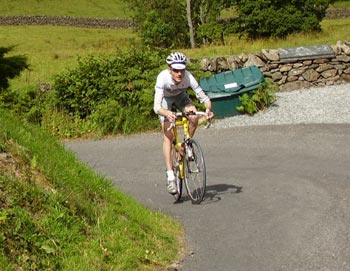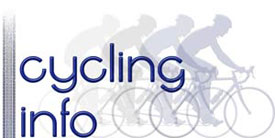
I love training almost as much as racing. I think to enjoy training is a very important aspect. If you have motivation and enthusiasm; if you are positive about riding, then you are going to make much more progress than if you just feel you need to churn out the miles to meet some training target.
These are some of my training tips
Realistic Plan. I’m not a great believer in writing out complicated plans and ambitious training schedules. I like to retain a certain flexibility. But, at the start of each year / month / week, I try to be conscious of what I want to achieve in that particular week / month. For example, at the start of March, I want to get prepared for the first races, by doing some hard hilly rides in preparation for the hilly time trials.
Flexibility. It’s important to be flexible. Don’t train when over tired. Don’t fret over losing a day. If you feel strong and have more time, push yourself a bit harder.
Train Hard. We are striking a balance between stress and recovery and avoiding over training. But, if you really want to make progress, you need to train hard. I rather like Emil Zatopek’s philosophy. He said he tried to run really fast for a long time. It is said he did some interval sessions for upto 90 times
“Why should I practice running slow? I already know how to run slow.
I want to learn to run fast.”- Emil Zatopek
Ride by Time / effort not distance speed. Speed can be confusing. On a dual carriageway with tribars you can float along at 25 mph without much problem. But in the middle of winter, on a cold windy day on your winter training bike the same effort level may give you a speed of 16mph. Don’t be demoralised by the low speed. I actually love the switch over from winter to summer training bike around April when suddenly with warmer weather and faster bike, you can add an extra 1 mph to your speed.
Be careful of weight training. Some advise weight training as a great way to increase power and strength, especially in the winter. The key is not to strain your muscles, but, go for medium weights with many repetitions. As a cyclist you don’t need chunky leg muscles. Just see some of the top climbers who are very ‘wiry’
Keep a training diary. I find it fascinating looking back at training rides to see how a season develops. It encourages you to stick to a regular training scheme and measure progress. For example, in February I may do a test 10 mile TT to find how I am going. I am always shocked to do something like a 26 minute 10. It feels painfully slow. Yet, in a few months, I will be doing a 21 minute 10. A training diary can give you a few clues to progress and also encourage you to keep regular training.
Train with other people. I spend alot of my training time on my own. But, it is good to have 1 or 2 training sessions with other people. It provides company to help pass time on long base mile training sessions. It can also help you push yourself to your limits. When you are with other people, your natural competitiveness will come to the fore and this will help you train harder. Everyone is different, but, it is good to train with others, at least part of the time.
Tapering. To really get the peak performance it is important to taper for some key races. This basically involves reducing the duration of training to keep you fresh. However, at the same time you can’t taper for every race as you will not make enough progress. Some races you will be doing after a heavy training week.
Bring Newness into Training. Don’t just do the same training rides every day. Variety helps to keep a sense of newness. In winter don’t think you have to spend 3 months staying at a heart rate of 65-75%, it will do no harm to ride fast up a few hills. Look for new hills or routes to do interval training on. Even buy a mountain bike and do some off road training.
Blocks of sessions. The key to good training is periods of stress followed by recovery. After a very hard interval session, have a day or two of easy riding, to allow the body to recover. Similarly don’t churn out a high mileage week every week. After a high mile week have a lower mileage week
Stretching. Good stretching helps retain agility and flexibility, especially important as you get older…
Good warm up. Take at least 20 minutes of light spinning before you do intense work. This lessens the chance of injury. Similarly you need a good warm up to the season, with a good base of miles before any interval training.
Short training sessions can make a big difference. If you are very busy, even training for 30 mins to 1 hour can make a big difference to retaining fitness. If you stop quickly after 10 days, your fitness will deteriorate rapidly. It takes 3 times as long to regain what you lose. Even training for 30 minutes can help retain your fitness.
Cross Training. I’m not a great fan of cross training, but, it has many advantages especially if you can’t cycle for some reason. The best form of cross training is swimming followed by walking up stairs.
Training in the wind. For psychological reasons I like to avoid setting off with a strong tailwind. I would rather ride into a headwind and cycle back with a tailwind. If the wind is very strong try to ride into a cross wind.
- Interval training
- Training for a 10 mile time trial
- Training for cycle sportives
- Perspectives on interval training
- Avoiding Overtraining

Hi, are you going to enter the beacon little mountain time trial this year? I entered last year and have sent an entry off again for this year.
You would do really well as it is really hilly, especially from 17 miles to the end at 39miles. As well as prizes for the overall they have two timed climbs with a seperate prize for the fastest combined hill climbs during the race. They also have a prize for the fastest person on a standard road bike rather than a tt bike.
http://www.beaconrcc.org.uk/open_races/lmtt/index.html